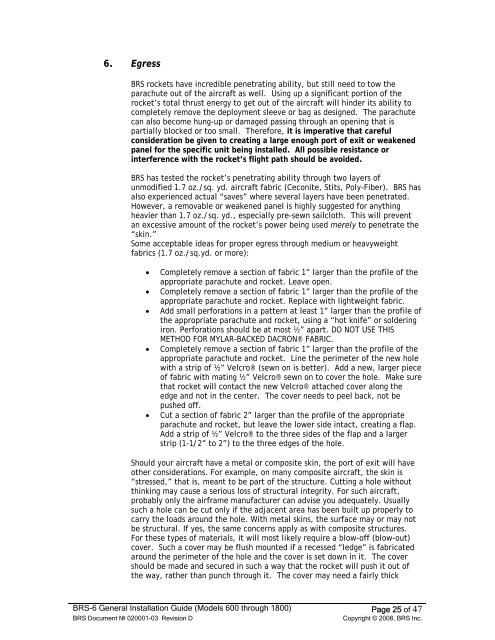BRS-6 General Installation Guide - CAFE Foundation
BRS-6 General Installation Guide - CAFE Foundation
BRS-6 General Installation Guide - CAFE Foundation
You also want an ePaper? Increase the reach of your titles
YUMPU automatically turns print PDFs into web optimized ePapers that Google loves.
6. Egress<br />
<strong>BRS</strong> rockets have incredible penetrating ability, but still need to tow the<br />
parachute out of the aircraft as well. Using up a significant portion of the<br />
rocket’s total thrust energy to get out of the aircraft will hinder its ability to<br />
completely remove the deployment sleeve or bag as designed. The parachute<br />
can also become hung-up or damaged passing through an opening that is<br />
partially blocked or too small. Therefore, it is imperative that careful<br />
consideration be given to creating a large enough port of exit or weakened<br />
panel for the specific unit being installed. All possible resistance or<br />
interference with the rocket’s flight path should be avoided.<br />
<strong>BRS</strong> has tested the rocket’s penetrating ability through two layers of<br />
unmodified 1.7 oz./sq. yd. aircraft fabric (Ceconite, Stits, Poly-Fiber). <strong>BRS</strong> has<br />
also experienced actual “saves” where several layers have been penetrated.<br />
However, a removable or weakened panel is highly suggested for anything<br />
heavier than 1.7 oz./sq. yd., especially pre-sewn sailcloth. This will prevent<br />
an excessive amount of the rocket’s power being used merely to penetrate the<br />
“skin.”<br />
Some acceptable ideas for proper egress through medium or heavyweight<br />
fabrics (1.7 oz./sq.yd. or more):<br />
• Completely remove a section of fabric 1” larger than the profile of the<br />
appropriate parachute and rocket. Leave open.<br />
• Completely remove a section of fabric 1” larger than the profile of the<br />
appropriate parachute and rocket. Replace with lightweight fabric.<br />
• Add small perforations in a pattern at least 1” larger than the profile of<br />
the appropriate parachute and rocket, using a “hot knife” or soldering<br />
iron. Perforations should be at most ½” apart. DO NOT USE THIS<br />
METHOD FOR MYLAR-BACKED DACRON® FABRIC.<br />
• Completely remove a section of fabric 1” larger than the profile of the<br />
appropriate parachute and rocket. Line the perimeter of the new hole<br />
with a strip of ½” Velcro® (sewn on is better). Add a new, larger piece<br />
of fabric with mating ½” Velcro® sewn on to cover the hole. Make sure<br />
that rocket will contact the new Velcro® attached cover along the<br />
edge and not in the center. The cover needs to peel back, not be<br />
pushed off.<br />
• Cut a section of fabric 2” larger than the profile of the appropriate<br />
parachute and rocket, but leave the lower side intact, creating a flap.<br />
Add a strip of ½” Velcro® to the three sides of the flap and a larger<br />
strip (1-1/2” to 2”) to the three edges of the hole.<br />
Should your aircraft have a metal or composite skin, the port of exit will have<br />
other considerations. For example, on many composite aircraft, the skin is<br />
“stressed,” that is, meant to be part of the structure. Cutting a hole without<br />
thinking may cause a serious loss of structural integrity. For such aircraft,<br />
probably only the airframe manufacturer can advise you adequately. Usually<br />
such a hole can be cut only if the adjacent area has been built up properly to<br />
carry the loads around the hole. With metal skins, the surface may or may not<br />
be structural. If yes, the same concerns apply as with composite structures.<br />
For these types of materials, it will most likely require a blow-off (blow-out)<br />
cover. Such a cover may be flush mounted if a recessed “ledge” is fabricated<br />
around the perimeter of the hole and the cover is set down in it. The cover<br />
should be made and secured in such a way that the rocket will push it out of<br />
the way, rather than punch through it. The cover may need a fairly thick<br />
<strong>BRS</strong>-6 <strong>General</strong> <strong>Installation</strong> <strong>Guide</strong> (Models 600 through 1800) Page 25 of 47<br />
<strong>BRS</strong> Document № 020001-03 Revision D Copyright © 2008, <strong>BRS</strong> Inc.

















